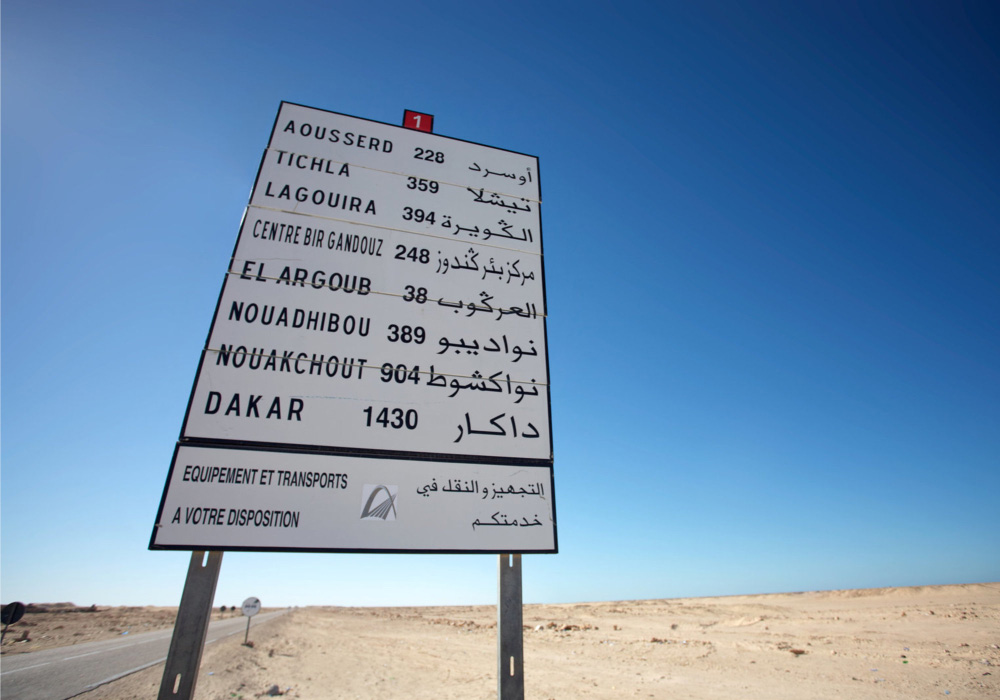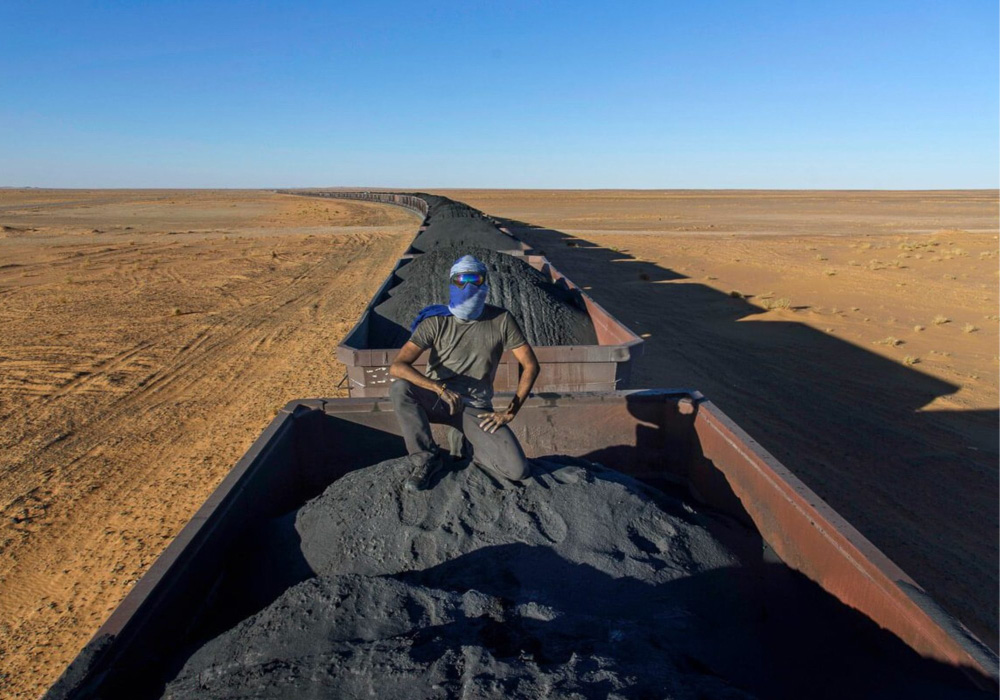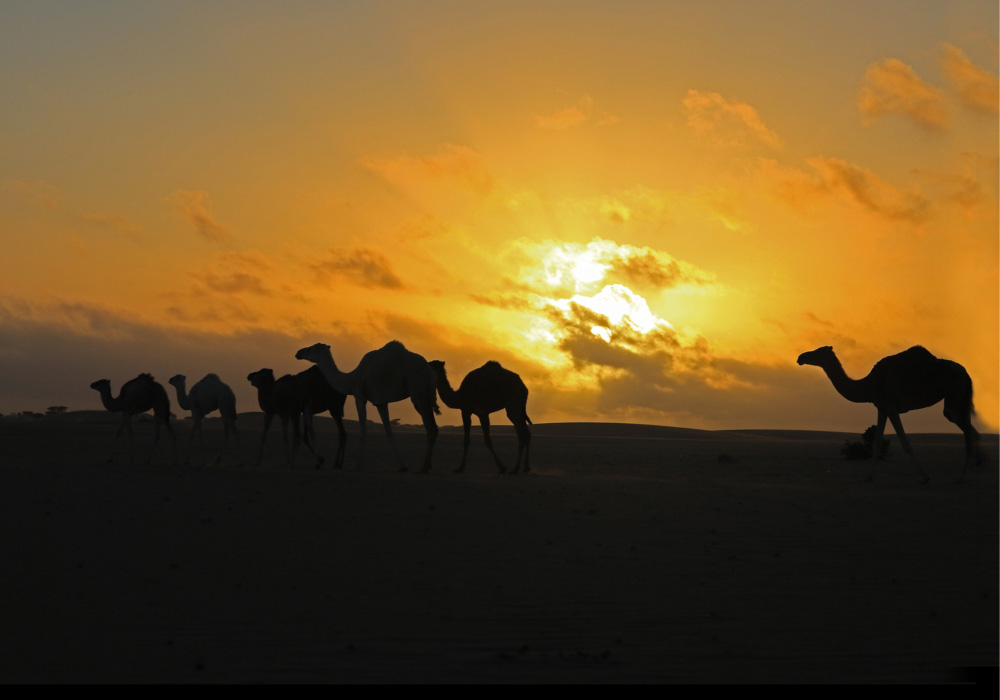Ride one of the world’s longest trains through the heart of the Sahara. The Iron Ore Train in Mauritania is a journey of adventure, endurance, and stunning landscapes.
The Iron Ore Train in Mauritania is one of the longest trains in the world, offering an unparalleled journey through the vast and unforgiving Sahara Desert. Stretching over 700 kilometres from the mining town of Zouérat to the port city of Nouadhibou, this train serves both economic and passenger needs.
Unlike traditional train rides, this experience is raw and challenging—travellers ride atop open-air wagons filled with iron ore and are exposed to extreme weather conditions. While it lacks luxury, the Iron Ore Train provides a rare and unfiltered connection to Mauritania’s landscapes, people, and history.
For those seeking adventure and authenticity, this journey is unforgettable. Here’s everything you need to know before embarking on this once-in-a-lifetime experience.
Mauritania and the Iron Ore Train’s role
Mauritania is located in Northwest Africa, bordered by the Atlantic Ocean to the west, Western Sahara to the north, Algeria to the northeast, Mali to the east and southeast, and Senegal to the southwest. The country is mostly covered by the Sahara Desert, with Nouakchott as its capital and largest city. The Iron Ore Train is a key part of its economy, transporting vast amounts of iron ore for export and connecting remote communities.
Built in the early 1960s after Mauritania gained independence, the railway was a major undertaking, overcoming the harsh desert terrain. Today, it remains a vital transport link for both industry and locals, while also attracting adventurous travellers.
The Iron Ore Train is not just a mode of transport; it is a lifeline for many and a symbol of Mauritania's rich history and culture. Let's dive into what makes this train ride so special and explore its historical significance.
Here are a few points that make it unique:
- Length and weight: Up to 2.5 kilometres long and carries up to 84,000 tons of iron ore.
- Scenery: Sweeping views of the Sahara Desert.
- Adventure: Riding in open wagons with minimal comfort.
Travellers must be prepared for extreme conditions. Temperatures can soar during the day and plummet at night. The journey can take up to 20 hours, depending on conditions. Bring essentials like water, food, and warm clothing.
Historical significance
The Iron Ore Train was built shortly after Mauritania gained independence from France in 1960. The train was a key project aimed at boosting the country's economy. The main goal was to transport iron ore from the mines in the Sahara to the coast for export.
The construction of the railway was a monumental task. It involved laying tracks through the harsh and unforgiving Sahara Desert. The project required significant resources and labour. Despite the challenges, the railway was completed and has been in operation ever since.
The train also played a role in connecting isolated communities. Before the railway, many towns in the Sahara were cut off from the rest of the country. The train provided a lifeline, bringing goods and people to remote areas.
Over the decades, it has become a symbol of Mauritania's resilience and determination. The train stands as a testament to the country's ability to overcome challenges and build a vital infrastructure.
It remains a crucial part of Mauritania's economy and heritage. Riding this train is not just a journey; it is a ride through history.
Planning your journey
Planning your journey is crucial to ensure a smooth and enjoyable experience. From choosing the best time to visit to understanding how to get there, careful preparation will help you make the most of your trip.

Best time to visit
Mauritania experiences extreme weather conditions, so timing your visit wisely is essential. The best time to ride the Iron Ore Train is during the cooler months, from November to February. Here's why:
- Temperatures: Daytime temperatures are more bearable, ranging from 20°C to 25°C (68°F to 77°F).
- Comfort: Cooler weather means a more comfortable ride on the open-air train cars.
- Scenic Views: Clear skies provide better visibility for enjoying the stunning desert landscapes.
During the summer months, from June to August, temperatures can soar above 40°C (104°F), making the journey extremely challenging and uncomfortable. Sandstorms are also more frequent, which can impact visibility and overall safety. Planning your trip for the cooler months will ensure a safer and more pleasant experience.
Getting to Mauritania
Reaching Mauritania requires careful planning, as it is not a typical tourist destination. Here are the main steps to get there:
- Flights: The main international airport is Nouakchott-Oumtounsy International Airport (NKC). Major airlines such as Air France and Turkish Airlines offer flights to Nouakchott.
- Visa: Ensure you obtain a visa before travelling. Some nationalities can get a visa on arrival, but it's safer to check with the Mauritanian embassy or consulate in your country.
- Local transport: From Nouakchott, you can take a domestic flight to Nouadhibou, the starting point for the Iron Ore Train. Alternatively, you can travel by bus or taxi, which takes around 7-8 hours.
Ticketing and pricing
Riding the Iron Ore Train in Mauritania is an adventure like no other. This train is one of the longest in the world, stretching over 2.5 kilometres. For travellers, understanding the ticketing and pricing can be daunting. This guide will help you navigate the process with ease.
Where to buy tickets
Buying tickets for the Iron Ore Train is straightforward. You have a few options:
- At the station: The most common way is to buy tickets directly at the station. Stations in Nouadhibou and Zouérat have ticket offices.
- Through local agents: Some local travel agents in Mauritania offer ticket-purchasing services. They may charge a small fee for this convenience.
- Onboard: In some cases, you can buy tickets directly from the conductor once you are on the train. This option is less reliable but can be useful if you miss the station's ticket office hours.
When buying tickets at the station, it's advisable to arrive early. Queues can be long, especially during peak travel times. The ticket offices usually open a few hours before the train's departure. Make sure you have local currency (Ouguiya) as they may not accept credit cards.
Here is a simple table showing the ticket office locations:
| City | Station | Operating Hours |
|---|---|---|
| Nouadhibou | Nouadhibou Station | 8 AM - 6 PM |
| Zouérat | Zouérat Station | 7 AM - 5 PM |
Buying tickets from local agents can save time. They often have up-to-date information on train schedules and availability. Contacting them a day or two in advance is recommended to ensure you get a seat.
Cost breakdown
The cost of riding the Iron Ore Train varies depending on the class and distance. Here's a breakdown:
- Passenger carriage: The most comfortable option. Prices range from 5,000 to 7,000 Ouguiya for a one-way trip.
- Iron Ore wagon: A more adventurous and budget-friendly option. Prices are lower, around 3,000 Ouguiya for a one-way trip. Note that this is not the most comfortable option.
Passenger carriages offer basic seating and some protection from the elements. Iron Ore Wagons are open-air and can be dusty and challenging, but they provide a unique experience.
Here’s a cost comparison in a table:
| Class | Price (Ouguiya) | Comfort Level |
|---|---|---|
| Passenger Carriage | 5,000 - 7,000 | High |
| Iron Ore Wagon | 3,000 | Low |
It's essential to carry enough cash for your journey. While some stations and agents accept credit cards, it's not guaranteed. Having local currency ensures you won't face any issues.
Remember, prices can fluctuate based on demand and season. It's a good idea to check with locals or recent travellers for the latest information. This will help you plan and budget effectively.
The train experience
The Iron Ore Train in Mauritania is one of the longest trains in the world. Riding it is a unique adventure. It stretches over 700 kilometres from the mining town of Zouérat to the port city of Nouadhibou. The journey offers a raw, authentic glimpse into Mauritania's desert landscape. The experience is both challenging and rewarding.

Inside the train
Riding the Iron Ore Train is not your typical train journey. Passengers usually ride in open wagons filled with iron ore. The train itself is a behemoth, with over 200 cars, and the ride can take around 20 hours. It’s an experience like no other.
Here’s what to expect inside the train:
- Open wagons: Most travellers sit on top of the iron ore. It’s a rough and dusty ride, so prepare to get dirty.
- Wind and sand: The wind blows sand and dust constantly. Wearing goggles and a scarf can help protect your eyes and face.
- Temperature extremes: It can be scorching hot during the day and freezing cold at night. Dress in layers to stay comfortable.
- Limited shelter: There are no roofs or walls in the wagons. Bring a tarp or blanket for some protection.
Facilities available
The facilities on the Iron Ore Train are extremely basic. It’s important to come prepared. Here’s what you need to know:
- No bathrooms: There are no toilets on the train. Be prepared to manage your needs in the open desert. Bring toilet paper and hand sanitizer.
- No food or water: There are no dining cars or food vendors. Bring plenty of water and snacks for the journey.
- No seating: There are no seats in the open wagons. Bring something soft to sit on, like a cushion or a thick blanket.
- No lighting: There are no lights on the train. Bring a flashlight or headlamp for nighttime.
Despite the lack of amenities, the Iron Ore Train offers a one-of-a-kind adventure. The stunning desert views and the camaraderie among fellow travellers make it a trip to remember.
Scenic views along the route
One of the most exciting aspects of this journey is the scenic views along the route. As the train snakes through the Sahara Desert, passengers are treated to breathtaking landscapes, dramatic sand dunes, and an array of fascinating sights. These scenes provide a visual feast that makes the journey unforgettable.
Notable landmarks
While riding the Iron Ore Train, you'll encounter several notable landmarks. These landmarks add depth and character to the journey. Here are some of the key highlights:
- Choum: A small village that serves as a crucial junction. It is surrounded by striking desert landscapes.
- Zouérat: Known for its iron mines, this town offers a glimpse into the mining industry that powers the train.
- Atar: Located near the Adrar Plateau, Atar is famous for its ancient architecture and vibrant markets.
- The Adrar Plateau: This stunning rocky plateau features unique geological formations and ancient rock art.
These landmarks are not just visually appealing but also steeped in history and culture. Each stop provides a deeper understanding of Mauritania's rich heritage. For example, the Adrar Plateau is home to some of the oldest rock carvings, offering a glimpse into the region's prehistoric past.
Wildlife sightings
Along the route, the Iron Ore Train provides ample opportunities for wildlife sightings. The Sahara Desert may seem barren, but it is teeming with life. Here are some of the animals you might spot:
- Fennec fox: This small, nocturnal fox is known for its large ears and playful nature.
- Dromedary camels: Often seen in herds, these camels are well-adapted to the harsh desert environment.
- Desert lizards: Various species of lizards, including the spiny-tailed lizard, can be seen basking on rocks.
- Birds of prey: Keep an eye out for eagles and falcons soaring high above the desert.

These wildlife encounters add an element of surprise and excitement to the journey. Spotting a fennec fox in the wild or watching a herd of camels traverse the dunes is a thrill. Each sighting is a reminder of the resilience and adaptability of desert animals.
For those who love nature and wildlife, the Iron Ore Train offers a unique chance to see these creatures in their natural habitat. These moments create lasting memories and enrich the overall experience of the journey.
Safety tips for travellers
Riding the Iron Ore Train in Mauritania offers a unique and adventurous experience. However, safety should always be your top priority. Here are some essential safety tips for travellers to ensure a safe and enjoyable journey.
Personal safety
Your personal safety is crucial while riding the Iron Ore Train. Here are some key tips to keep in mind:
- Travel in groups: Always travel with a group or at least one other person. This increases your safety and provides support in case of emergencies.
- Secure your belongings: Keep your valuables close to you. Use a secure bag or backpack that you can easily keep an eye on.
- Avoid travelling at night: The train journey can be more dangerous at night. Try to plan your trip during daylight hours.
In addition to these tips, prepare for the journey by bringing appropriate gear:
| Item | Purpose |
|---|---|
| Sturdy shoes | For walking on uneven surfaces and climbing onto the train |
| Protective clothing | To shield against dust and harsh weather conditions |
| Headlamp | For visibility during the night or in dark areas |
Health precautions
Maintaining your health during the journey is essential. Here are some health precautions to consider:
- Stay hydrated: Bring plenty of water. The journey can be long and the climate is often hot and dry.
- Pack snacks: Bring non-perishable food items to keep your energy levels up.
- Wear a mask: To protect against dust, especially while riding in open wagons.
Also, prepare a basic health kit with the following items:
- First aid kit: Include bandages, antiseptics, and basic medications.
- Sunscreen: To protect against sunburn.
- Hand sanitizer: To maintain hygiene.
By following these health precautions, you can ensure a safer and more comfortable journey on the Iron Ore Train in Mauritania.
Cultural insights
Riding the Iron Ore Train in Mauritania is an adventure like no other. This journey offers not only breathtaking landscapes but also a deep dive into the local culture. Understanding the cultural nuances is essential for a respectful and enriching experience. Let's explore the cultural insights that will make your journey more meaningful.
Local communities
As you travel on the Iron Ore Train, you will encounter various local communities. These communities are often small, but they are rich in tradition and hospitality. The people you meet along the way can offer invaluable insights into their way of life.
Here are some key points about the local communities:
- Hospitality: The Mauritanian people are known for their warm hospitality. They often invite travellers for tea, a gesture of welcome and friendship.
- Language: Arabic is the official language, but many people also speak French. Learning a few basic phrases can go a long way in building connections.
- Economy: Many local communities rely on small-scale farming and livestock. Understanding their economic activities can provide context to their daily lives.
- Religion: Islam is the predominant religion. Respect for their religious practices, such as prayer times and dress codes, is crucial.
Engaging with local communities can be a rewarding experience. It can teach you about their resilience, resourcefulness, and a strong sense of community. Their stories and experiences add a rich layer to your journey.
Cultural etiquette
Respecting cultural etiquette is essential when travelling through Mauritania. Here are some guidelines to help you navigate social interactions smoothly:
- Dress modestly: Both men and women should dress conservatively. Women should cover their heads with a scarf when entering villages or religious sites.
- Greetings: Greetings are an important part of social interactions. A handshake, followed by placing your hand on your heart, is a common gesture of respect.
- Dining etiquette: If invited for a meal, wash your hands before eating. It is customary to eat with your right hand and accept offerings graciously.
- Gift-giving: Small gifts, like tea or sweets, are appreciated when visiting someone's home. Avoid giving alcohol as it is prohibited in Islam.
Understanding and respecting these etiquettes can enhance your travel experience. It shows your respect for their culture and helps in building positive relationships. Remember, a smile and genuine interest go a long way in any cultural exchange.
Final thoughts: A journey like no other
Riding the Iron Ore Train in Mauritania is more than just transportation—it’s an adventure of endurance, history, and unparalleled landscapes. This journey challenges travellers with extreme conditions but rewards them with stunning desert views, cultural encounters, and a sense of accomplishment.
Preparation is key—packing wisely, understanding the risks, and respecting the local culture will ensure a more enjoyable experience. Whether you’re drawn to the adventure, the history, or the breathtaking scenery, this train ride is one of the most extraordinary travel experiences in the world.
If you’re ready for the challenge, start planning your Iron Ore Train journey today!



Comments powered by CComment